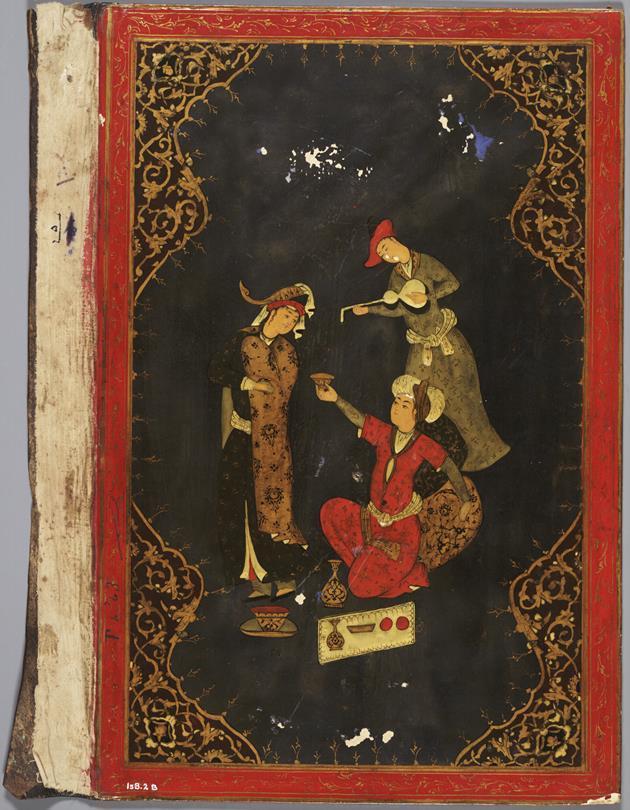Book Cover Interior with Yusuf (Joseph) and Man With Attendants
18th century
The story of Joseph forms part of Muslim, Jewish and Christian holy texts. The chapter dedicated to Joseph (Yusuf in Arabic) in the Qur'an is the most sustained narrative in the Muslim holy book. There was an interest in elaborating on the Qur'anic narrative, however, and one of the most famous literary works based on this story was the poet Jami's Yusuf and Zulaykha, written in Persian in 1483.
The Qur'an refers to Yusuf's seduction at the hand of the wife of the ruler of Egypt, as does the biblical narrative. In Jami's poem, however, this female character receives a name, Zulaykha, as well as a more complex personality. She is a beautiful young woman who falls in love with Yusuf when she sees him in a dream. She must then endure many trials and overcome numerous obstacles to achieve a physical and spiritual union with her true love.
This love story was immensely popular and versions of it formed part of literary anthologies, including the Haft Awrang (Seven Thrones) of Jami and Sa'di's Bustan (Orchard). The Yusuf story epitomizes the potential to understand love on both literal and metaphorical levels. Yusuf and Zulaykha engage in a melodramatic, sometimes tragic romance, but we can come to understand both figures, especially Yusuf, as exemplars of piety, virtue and the beauty of spiritual love.
Numerous illustrations of the Yusuf story exist; in fact, surviving images indicate that Jami's narrative was illustrated in his lifetime, a testament to the instant popularity of the story. In this set of book covers, scenes of Yusuf and his brothers decorate one face of each cover. In both images, Yusuf sits in state, surrounded by his brethren, immediately before or after he reveals his identity to them. On one cover he is shown in a princely or courtly guise, seated on a throne as he addresses his family members. In the pendant scene, Yusuf has the fiery halo and veil of a prophetic figure, alluding to his piety and obedience to God. On the opposite side of each book cover are more generic courtly scenes of figures feasting in a garden setting, which might represent the aristocratic patron who commissioned such a luxurious book.
Paint and lacquer on papier-mâché
14 5/8 x 9 3/4 in. (37.2 x 24.8 cm)
Eugene Fuller Memorial Collection
42.12.2
Provenance: Purchased from David Benzaria, New York in 1942; Eugene Fuller Memorial Collection
Photo: Paul Macapia





